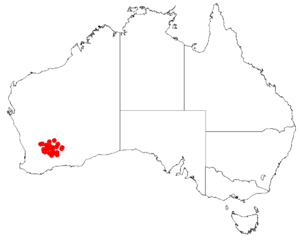Persoonia inconspicua facts for kids
Quick facts for kids Persoonia inconspicua |
|
|---|---|
| Scientific classification | |
| Genus: |
Persoonia
|
| Species: |
inconspicua
|
 |
|
| Occurrence data from Australasian Virtual Herbarium | |
Persoonia inconspicua is a type of flowering plant that belongs to the Proteaceae family. It grows only in the south-west part of Western Australia. This plant is a shrub that stands tall or spreads out. When it's young, its small branches and leaves are quite hairy. It has long, thin leaves and small, greenish-yellow flowers that usually grow one or two at a time.
Contents
About the Plant
Persoonia inconspicua is a shrub that can grow from about 0.5 to 2.5 meters (about 1.5 to 8 feet) tall. It often grows upright or spreads out. The plant has smooth bark. Its young branches are covered in thick hairs for the first year or two.
Leaves and Flowers
The leaves of this plant are arranged one after another along the stem. When they are young, they are very hairy. The leaves are long and thin, like a line, and are about 20 to 65 millimeters (0.8 to 2.5 inches) long. They are also about 0.7 to 1.3 millimeters (0.03 to 0.05 inches) wide and have a groove on their underside.
The flowers are usually found alone or in pairs. Each flower grows on a short, hairy stalk called a pedicel, which is about 1 to 2.5 millimeters long. The flower parts, called tepals, are greenish-yellow and hairy on the outside. They are about 8 to 10.5 millimeters long. Inside, the white anthers (the parts that hold pollen) curve outwards near their tips.
Life Cycle
This plant flowers from June to September. After flowering, it produces a smooth fruit called a drupe. A drupe is a fleshy fruit with a hard pit inside, like a peach or a cherry.
Where It Lives
This special plant, also known as a geebung, usually grows in areas with heathland and woodland. You can find it in specific parts of Western Australia, including Cowcowing Lakes, Mt Jackson, Queen Victoria Rock, and the Johnston Lakes. These areas are part of the Avon Wheatbelt, Coolgardie, and Mallee regions.
Discovery and Naming
Persoonia inconspicua was first officially described in 1994. A scientist named Peter Weston wrote about it in a science journal called Telopea. He used plant samples that another scientist, Paul Wilson, had collected in 1970, north of a place called Bullfinch.
Conservation Status
The Western Australian Government's Department of Parks and Wildlife has classified Persoonia inconspicua as "not threatened." This means the plant is not currently in danger of disappearing.

